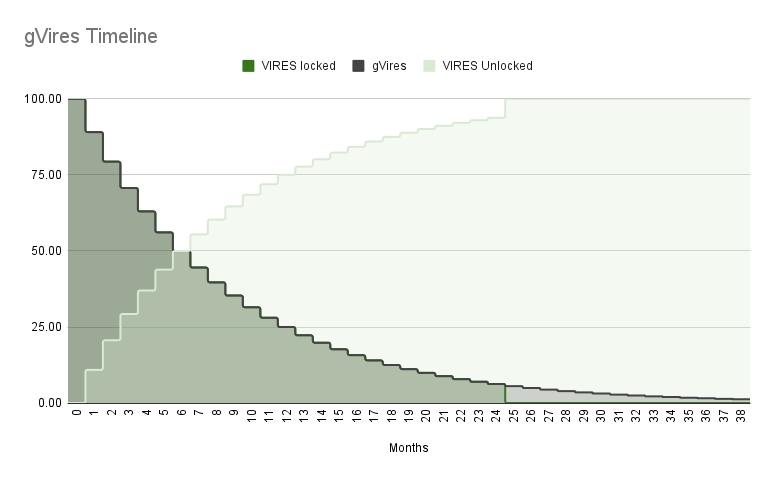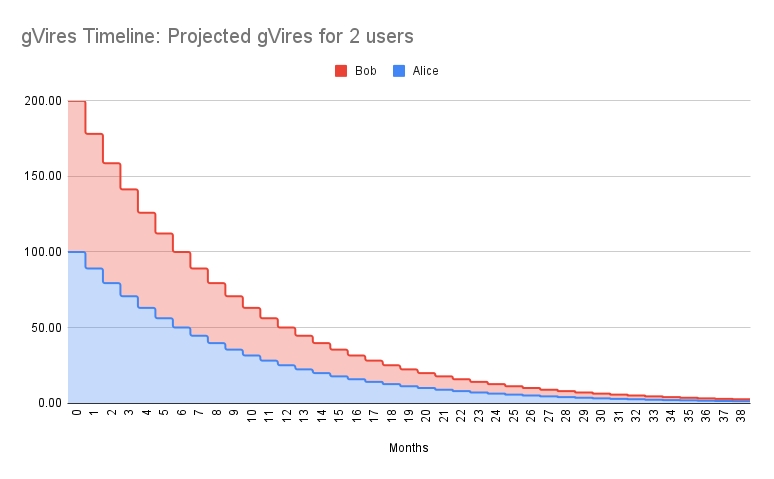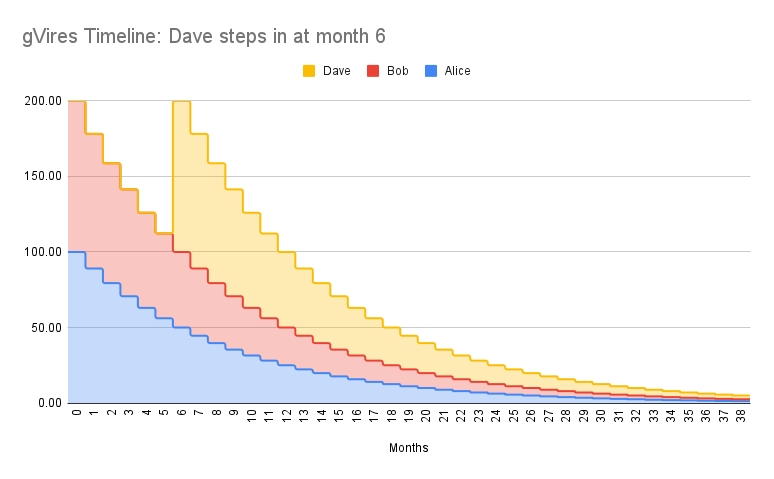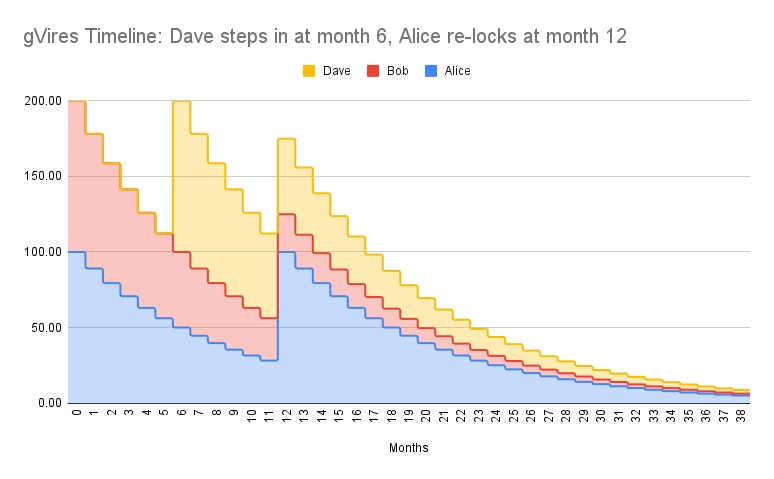gVires Math
All the related math you need to know
VIRES, gVires & Half-life
The core of math is simple: At any time, accounts lose half of their current commitment in 6 months. The algorithm is based on a half-life decay formula:
Given a user commits Vires tokens at time ,
where indicates the decay speed(half-life time):
Example for 1 particpant
For example, a user X1-locked 100 Vires on Jan 1, 2022. The user’s governance power starts decaying; his tokens start to unlock:
Date
gVires
Still locked VIRES
Unlocked VIRES
Jan 1, 2022, 00:00
100.00 gVires
100.00 ⓥ
0.00 ⓥ
Feb 1, 2022
89.09 gVires
89.09 ⓥ
10.91 ⓥ
Mar 1, 2022
79.37 gVires
79.37 ⓥ
20.63 ⓥ
Apr 1, 2022
70.71 gVires
70.71 ⓥ
29.29 ⓥ
May 1, 2022
63.00 gVires
63.00 ⓥ
37.00 ⓥ
June 1, 2022
56.12 gVires
56.12 ⓥ
43.88 ⓥ
July 1, 2022
50.00 gVires
50.00 ⓥ
50.00 ⓥ
…
…
…
…
Jan 1, 2023
25.00 gVires
25.00 ⓥ
75.00 ⓥ
…
…
…
…
July 1, 2023
12.50 gVires
12.50 ⓥ
87.50 ⓥ
…
…
…
…
Jan 1, 2024, 00:00
6.25 gVires
0.00 ⓥ
100 ⓥ
…
…
…
…

As illustrated above,
The unlock starts immediately after locking VIRES,
In half a year, the users’s amount of gVires gets halved; also, half of VIRES is free to be withdrawn,
In two years, there’s a cliff: user can withdraw all the rest vires now(6.25% of initial lock), although if he doesn’t do it, he still has the voting, governance, and revenue stream power(under the continued decay);
Example for multiple participants
Vires.finance markets take a cut of the interest that borrowers pay. The ‘Protocol share’ value can be found under any asset on the asset details page. Generally, it can be different for different markets, and this value is up to governance to configure. Let’s look at an example:
Borrowers on the USDC market have borrowed 100M USC for 36.5% APR,
Therefore, borrowers on the USDC market have to pay 100,000 USDC of interest today,
Protocol share for USDC is 10%; therefore, governance receive 10,000 USDC today,
Alice and Bob locked 100 VIRES each yesterday, totaling 200 gVires(by 100 gVires each), so Alice and Bob both received 5,000 USDC today;
Day 0:
user
VIRES in the system
Still locked VIRES = gVires
Already unlocked VIRES
gVires
Revenue share
Alice
100 ⓥ
100 ⓥ
0 ⓥ
100
50%
Bob
100 ⓥ
100 ⓥ
0 ⓥ
100
50%
Now, after half a year, all the gVires have decayed:
Alice accounts for 50 gVires, Bob accounts for 50 gVires(of now total 100), so they still split the revenue stream 50-50%,
user
VIRES in the system
Still locked VIRES = gVires
Already unlocked VIRES
gVires
Revenue share
Alice
100 ⓥ
50 ⓥ
50 ⓥ
50
50%
Bob
100 ⓥ
50 ⓥ
50 ⓥ
50
50%

Dave comes in and locks 100 VIRES, which grants him 100 gVires:
user
VIRES in the system
Still locked VIRES = gVires
Already unlocked VIRES
gVires
Revenue share
Alice
100 ⓥ
50 ⓥ
50 ⓥ
50
25%
Bob
100 ⓥ
50 ⓥ
50 ⓥ
50
25%
Dave
100 ⓥ
100 ⓥ
0 ⓥ
100
50%
Dave commits twice more than Alice, so he receives twice more than her in revenue: This day, — Alice receives 2500 USDC, — Bob receives 2500 USDC, — Dave receives 5000 USDC;

As illustrated in the examples, gVires is proportional to the total amount of VIRES still locked by a given user.
At any time, anyone else can re-lock their stake.
Here’s how the picture changes if Alice decides to re-lock her VIRES:
user
VIRES in the system
Still locked VIRES
Already unlocked VIRES
gVires
Revenue share
Alice
100 ⓥ
100 ⓥ
0 ⓥ
100
40%
Bob
100 ⓥ
50 ⓥ
50 ⓥ
50
20%
Dave
100 ⓥ
100 ⓥ
0 ⓥ
100
40%

Last updated
Was this helpful?